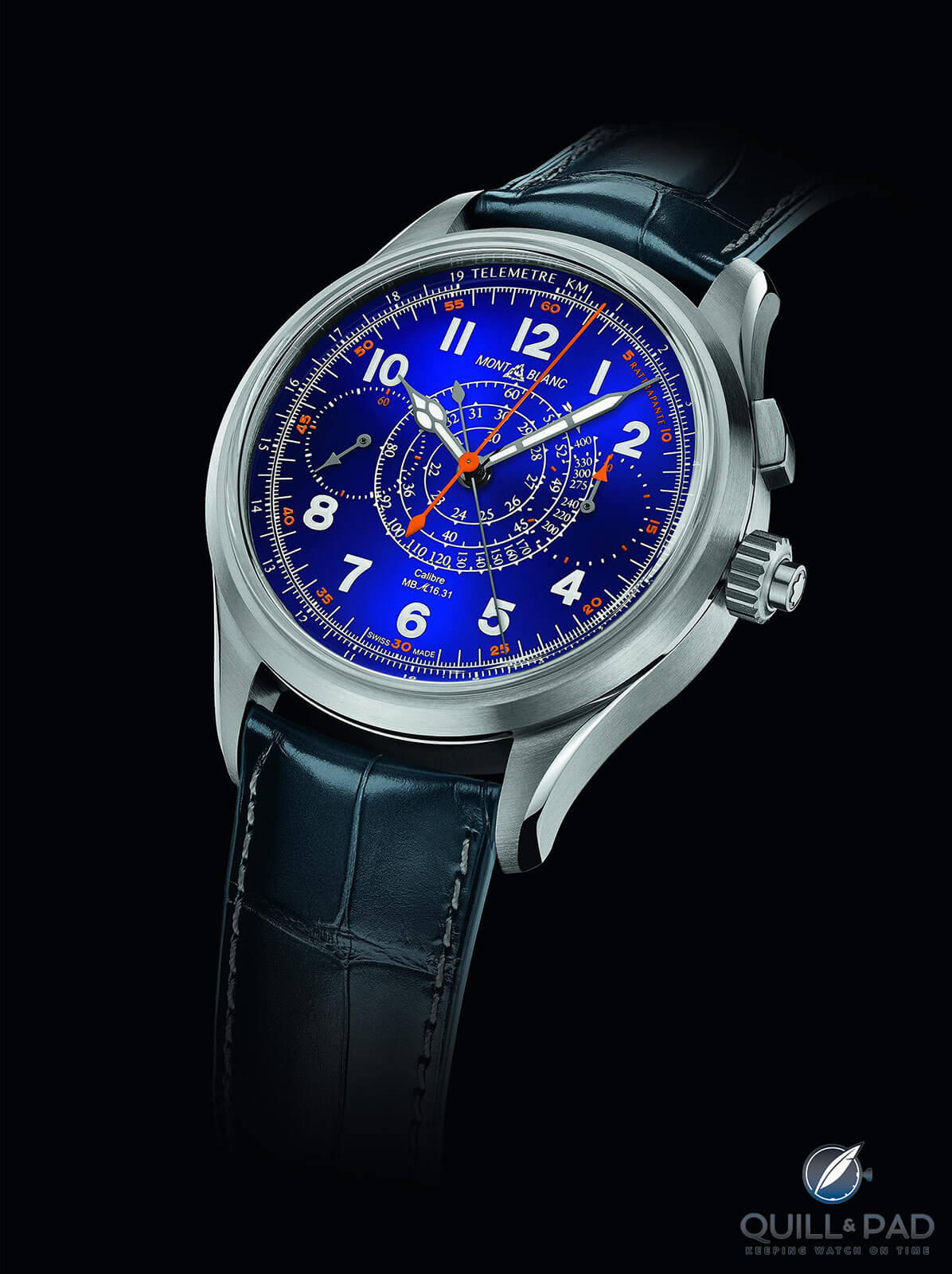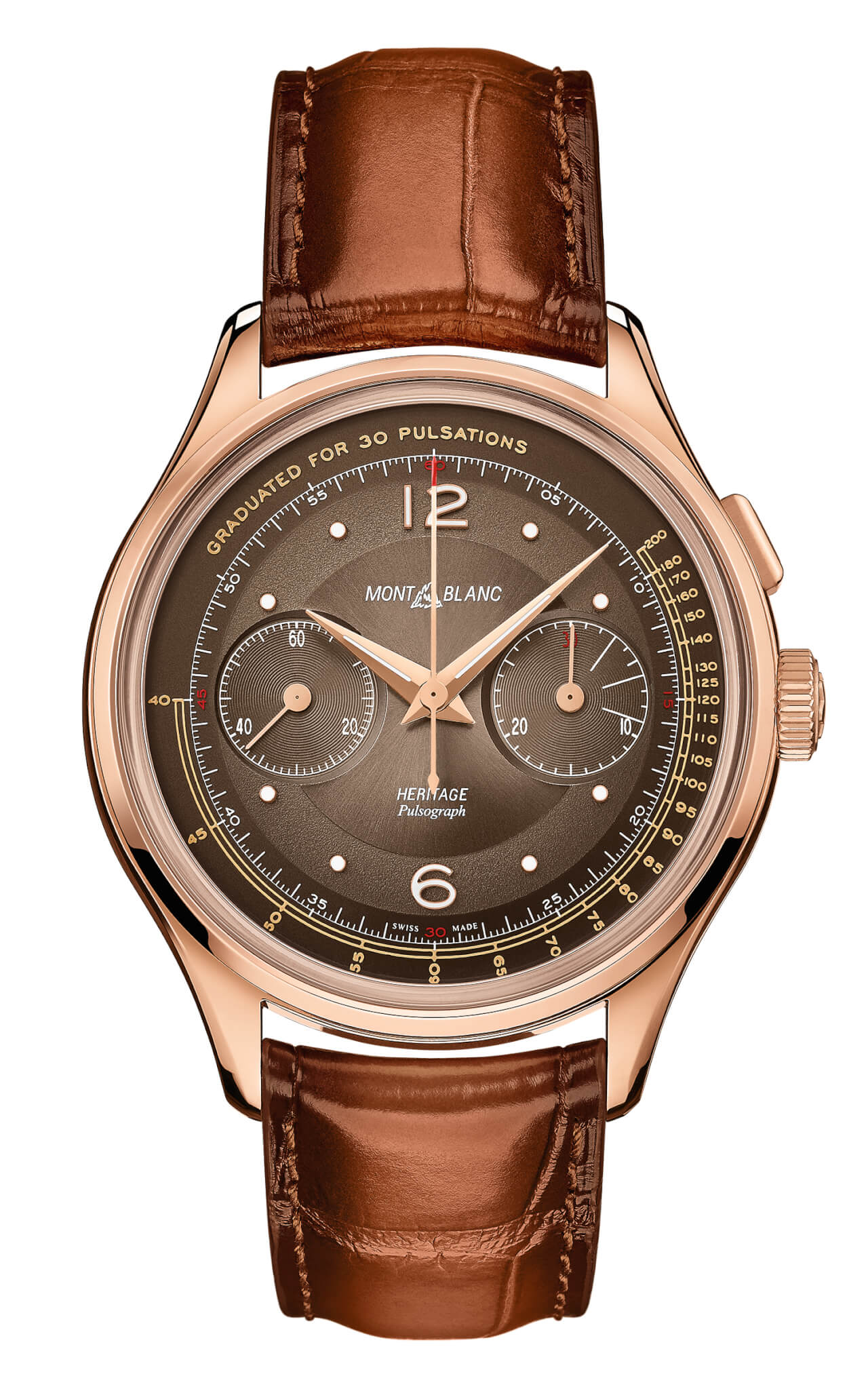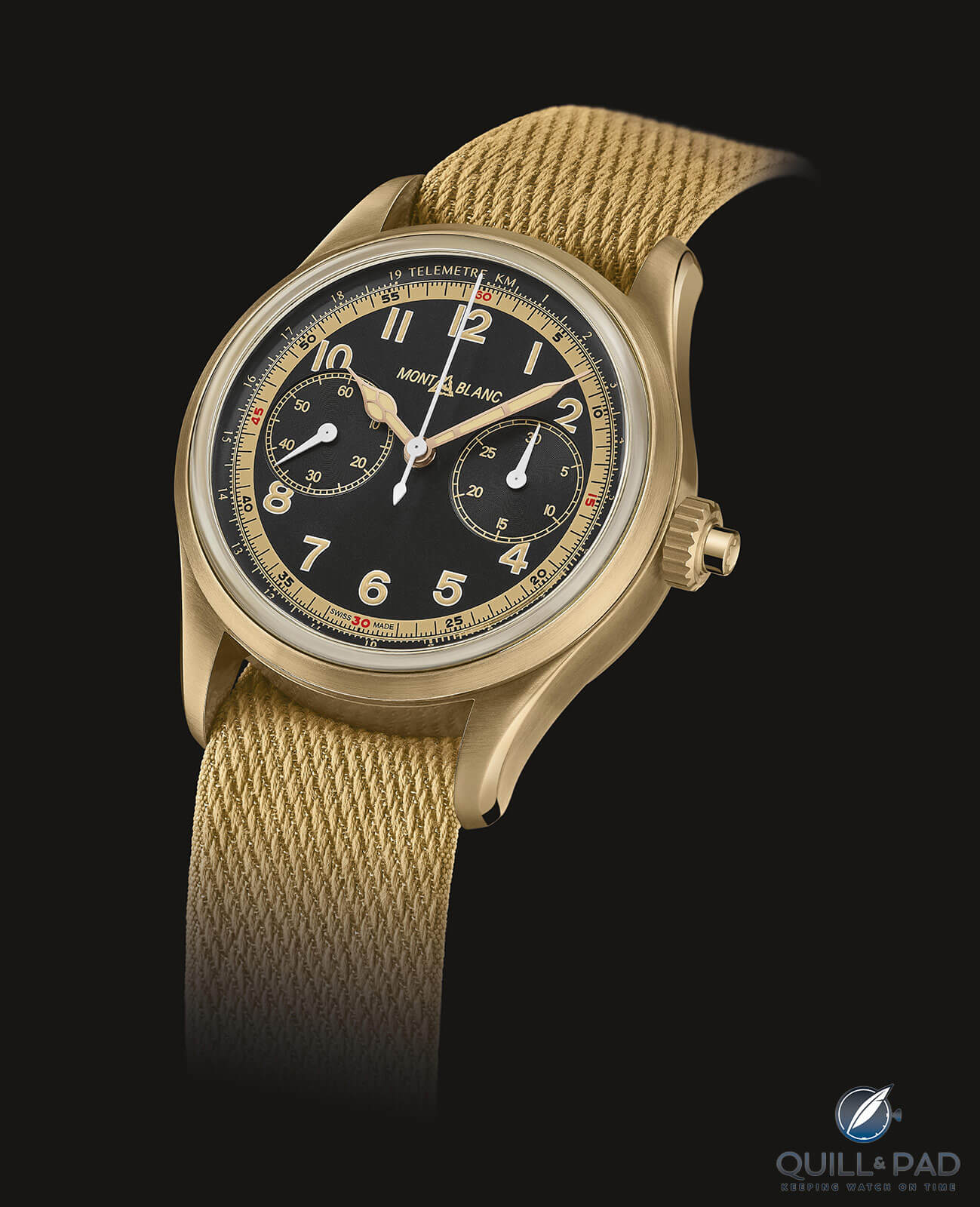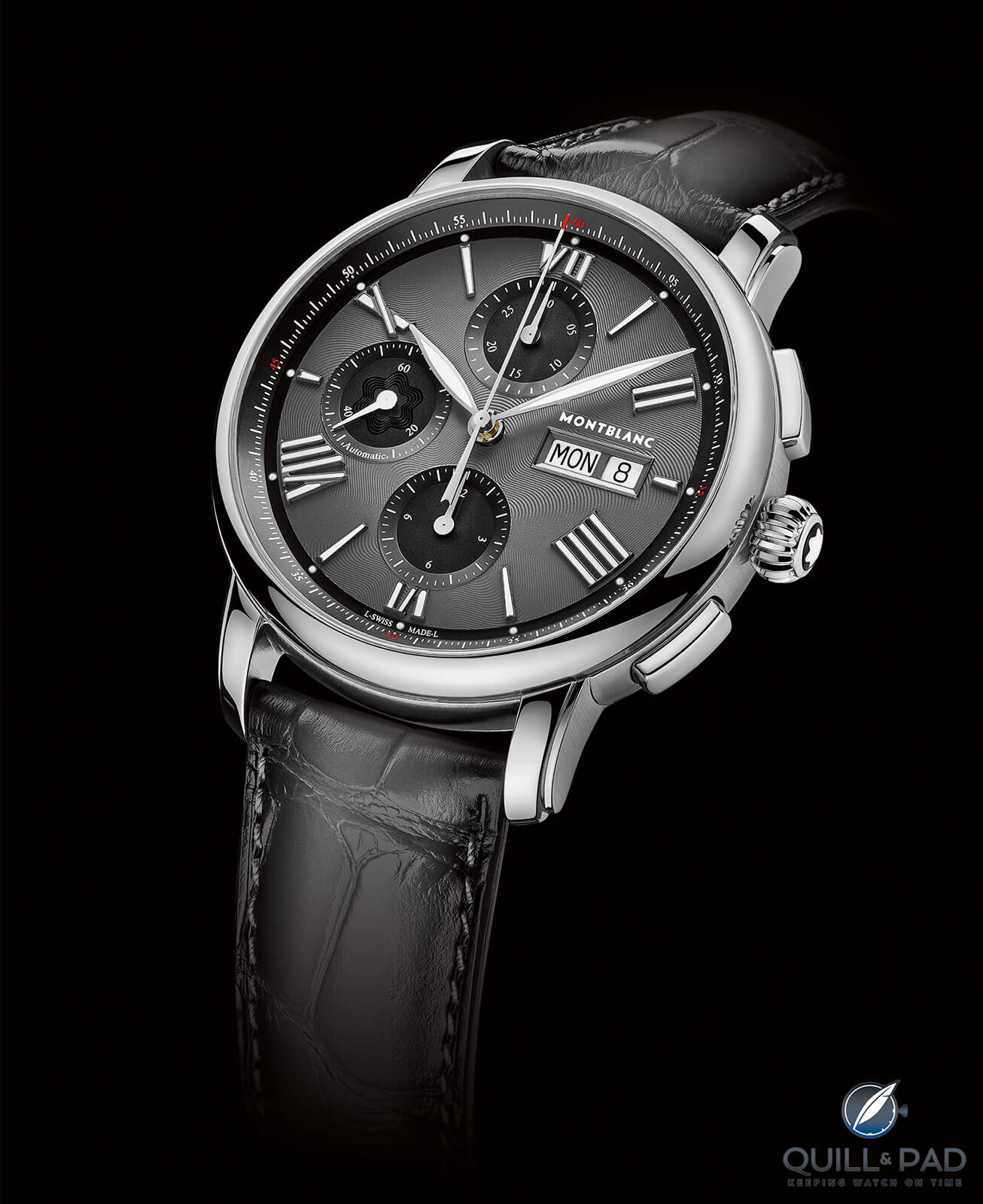Five Great Montblanc Chronographs For 2020: One For (Nearly) Every Occasion
by Martin Green
Some people still mourn the “loss” of Minerva, which had achieved cult status for its chronographs before being bought by Richemont in 2006 and incorporated into Montblanc.
For a few years I was among them, wondering if it wouldn’t have made better business sense to let Minerva flourish and gain market share with Richemont’s considerable financial and operational capabilities behind it.
Now that feeling has diminished as Montblanc has proven, especially over the last couple of years, that it didn’t let Minerva’s knowledge, history, and resources go to waste. Montblanc has used these elements to advantage for an array of movements that make even the most spoiled watch collectors draw in their breath.
What also helps is that Montblanc has kept the Minerva spirit alive, not only through the chiefly handmade and -decorated movements still manufactured in Minerva’s historical factory in Villeret, but also in their wonderful nostalgic design.
Montblanc 1858 Split Second Chronograph: old becomes new
One of the watches updating tradition beautifully is the new 1858 Split-Second Chronograph, which is based on a historic Minerva military monopusher chronograph from the 1930s. It is powered by a hand-wound movement that justifiably carries the Minerva name with pride.

Montblanc 1858 Split Second Chronograph on the wrist
Its main plate, made of German silver and decorated with circular graining, forms the backdrop for an array of cams, wheels, and levers making up the split-second chronograph mechanism. Technically it is a monopusher chronograph as it is started, stopped, and reset using the single button built into the crown, but an additional button is required to operate the split-second function.
The 1858 Split Second Chronograph features two column wheels. Students of horological history might also notice the distinct V-shaped chronograph bridge, which was patented in 1912 and shares its chamfered edges with the rest of the movement.

Montblanc 1858 Split Second Chronograph front and back
I am also particularly taken by the oversized balance wheel and the fact that it beats at the traditional 2.5 Hz / 18,000 vph rather than the faster rates more usually seen today.
While you may be tempted to concentrate in awe at the back of this watch, the front has a lot of charms of its own.
Exhibiting classic styling elements, the look is surprisingly modern thanks to its vibrant blue graduated dial. I was surprised when I learned that this dial is an oven-fired “grand feu” enamel, though given the obvious care and attention that has gone into the 1858 Split Second Chronograph, I shouldn’t have been.
There are not many watches that I would consider buying just for the dial, but this is one of them. In combination with the white and orange/red details and the snailing tachymeter scale, it is simply divine.

Montblanc 1858 Split Second Chronograph limited edition
At 44 mm, it is quite a large watch, but I doubt if it would reach its full effect if it were smaller. Also, it shares this diameter with the Minerva model that inspired it. Montblanc also had the common sense to make the case in titanium, which makes it much more wearable in terms of weight.
All told, this watch not a retro reincarnation, but a sensational modern torchbearer of past generations.
Quick Facts Montblanc 1858 Split Second Chronograph
Case: 44 x 14.55 mm, grade 5 titanium
Dial: gradient blue, high-fire enamel
Movement: hand-wound Caliber MB M16.31, 2.5 Hz/18,000 vph frequency, two-column wheels with horizontal coupling to control split-second chronograph function, rhodium-plated main plate and bridges, 50-hour power reserve
Functions: hours, minutes, seconds; split-second chronograph
Limitation: 100 pieces
Price: $36,000
Montblanc Heritage Manufacture Pulsograph: an elevated pulse
As an enthusiast of dress watches, my pulse always slightly elevates when I see a watch that gets it right in an understated way. Usually, the less is more maxim makes time-only watches more attractive to me.
However, it also occurred when I saw the new Heritage Manufacture Pulsograph, where Montblanc combines a pink gold case with a tobacco-colored dial. This instantly makes you want to sip mojitos in the sun while wearing a tailor-made linen suit. It may sound strange, but I feel that a pulsometer scale often gives a chronograph a different dynamic, especially when the maker opts for such a classic style as this Montblanc.

Montblanc Heritage Manufacture Pulsograph
At 40 mm, I also have to say that its proportions are masterful, especially from the front. Here a relatively thin bezel amplifies its classic appearance, leaving plenty of room on the dial to space out all the functions and scales, avoiding making it look overcrowded.
Because of its height of 12.65 mm, this is a watch that I would call pleasantly heavy on the wrist. Its weight will serve as a constant reminder that you are wearing something precious.
The heft is due to both the gold case and the movement: Caliber MB M13.21 is also a Minerva-pedigree caliber, featuring many of the styling elements also present on the movement of the 1858 Split Second Chronograph.
Most, if not all, of the decorations are made by hand, and the main plate and bridges are in red gold-plated German silver, making this Montblanc the full package. You essentially get a vintage Minerva movement made with modern-day production techniques, all encased in an elegant case and topped off with a stunning dial.
My pulse is still elevated, even as I write this.
Quick Facts Montblanc Heritage Manufacture Pulsograph
Case: 40 x 12.65 mm, pink gold
Dial: gradient tobacco-colored
Movement: hand-wound Caliber MB M13.21, 2.5 Hz/18,000 vph frequency, column wheel chronograph with horizontal coupling, red gold-plated main plate and bridges, 55-hour power reserve
Functions: hours, minutes, seconds; monopusher chronograph
Limitation: 100 pieces
Price: $33,000
Heritage and 1858 Monopusher Chronographs: classy, not pricey
The elegance of the Heritage Manufacture Pulsograph is matched by that of the Heritage Monopusher Chronograph, although they are entirely different watches. The fact that the Heritage Monopusher Chronograph lacks the now-traditional duo of chronograph pushers, replaced by a single pusher in the crown, gives it a very clean appearance.

Montblanc Heritage Monopusher Chronograph with salmon-colored dial
At 42 mm, it has presence without being too large. And it offers good value at $4,950 as it comes with delicacies often associated with higher price categories, including a salmon-colored dial with frosted, sunray finish.
The case back embossed with an image of the Minerva manufacture is a little misleading as it’s powered by Caliber MB 25.12, which is essentially a Sellita SW510. It’s a dependable monopusher movement that helps to keep the price down.
Those who find the Heritage Monopusher Chronograph a bit too dressy can always turn to the 1858 Monopusher Chronograph. With this watch, consumers get the same movement in a different package.

Montblanc 1858 Monopusher Chronograph variations
As the name already indicates, it boasts the vintage explorer style that is the hallmark of the 1858 collection. As a monopusher it is particularly pleasing, featuring a two-tone dial with cream-colored luminous material.

Montblanc 1858 Monopusher Chronograph in bronze on textile strap
While Montblanc offers it in both stainless steel and bronze cases, I would opt for the latter as it looks more harmonious with the vintage styling. However, the stainless steel version is also available on a vintage-styled bracelet, which looks particularly good.

Montblanc 1858 Monopusher Chronograph in bronze on textile strap
Again, Montblanc didn’t cut any corners with this watch. Its finish is up to par for its price category, and the 100-meter water-resistant rating is a pleasant surprise. It means that you can take confidently take this Montblanc on an expedition.
For more information, please visit montblanc.com/en-us/collection/watches/montblanc-heritage/montblanc-heritage-monopusher-chronograph and montblanc.com/en-us/collection/watches/montblanc-1858-collection/montblanc-1858-monopusher-chronograph.
Quick Facts Montblanc Heritage Monopusher Chronograph
Case: 42 x 14.7 mm, stainless steel
Dial: salmon-colored frosted finish
Movement: automatic Caliber MB 25.12 (based on Sellita SW510), 4 Hz/28,800 vph frequency, 48-hour power reserve
Functions: hours, minutes, seconds; monopusher chronograph
Price: $4,950
Quick Facts Montblanc 1858 Monopusher Chronograph
Case: 42 x 14.7 mm, stainless steel or bronze
Dial: black and cream-colored dial with cream-colored lume
Movement: automatic Caliber MB 25.12 (based on Sellita SW510), 4 Hz/28,800 vph frequency, 48-hour power reserve
Functions: hours, minutes, seconds; monopusher chronograph
Limitation: 1,858 pieces of the bronze piece; stainless steel unlimited
Price: $4,900 (stainless steel on strap), $5,200 (stainless steel on bracelet), $5,600 (bronze)
Montblanc Star Legacy Chronograph Day-Date: bread and butter
Montblanc’s Star Legacy Chronograph Day-Date reminds me of the glorious taste of fresh-baked bread lavishly spread with fresh butter.
The Star Legacy Chronograph Day-Date shares its movement with the two chronographs mentioned above: Caliber SW500, which is the Sellita alternative to the famed ETA Valjoux 7750.
Some may turn up a snobby noose to Sellita movements, but the fact of the matter is that they make up a significant portion of Swiss watch sales globally for Montblanc and other brands.

Montblanc Star Legacy Chronograph Day-Date in 43 mm
I once read an article about a Michelin-starred chef, whose name now escapes me, who wanted bread and butter as his last meal on earth and I think that Montblanc offers similar fare with the Star Legacy Chronograph Day-Date.
While its movement may be humble, it is rich in appearance. The 43 mm case worried me a bit at first, though, as this is substantially larger than the movement, forcing all the complications closer toward the center of the dial. Montblanc even added insult to injury by giving the watch a rather narrow bezel.
However, the design of the dial is so spot on that it counters all the reservations I had with flair. A slanted flange connects the bezel with the dial and is simultaneously home to a 60-second scale for the chronograph seconds.

Montblanc Star Legacy Chronograph Day-Date on the wrist
The two-tone setup of the dial works wonders, especially thanks to the guilloche pattern stamped on the dial and the running seconds subdial, the latter’s pattern is ever so subtly formed in the shape of a Montblanc star.
Montblanc even allows itself a playful touch by giving the Roman numerals for five and ten an unusual twist. The usual V and X Roman numerals have been replaced with markers that add a more contemporary touch to an otherwise ultra-classic watch.
These little things make the Star Legacy Chronograph Day-Date a tempting proposition – not least because of its excellent legibility.
Montblanc delivers it on both a strap and a metal bracelet. I know that a metal bracelet is essential in this part of the market, but I prefer the classic look of the leather strap.
The design of the bracelet is the traditional three-link style, giving the watch a plainer look and taking away some of the magic of the superbly designed dial. It also makes me wonder how this watch would have looked on a Milanese bracelet. Fortunately, such bracelets are also quite easy to obtain aftermarket.
That said, the Star Legacy Chronograph Day-Date can proudly stand beside its more complex siblings with head held high as it offers a generous dash of timeless style in combination with a reliable and robust movement at a relatively modest price point.
This is a watch I would proudly wear myself, preferably sampling some freshly baked bread with butter in the Swiss Alps while viewing Mont Blanc’s snowy cap.
For more information, please visit montblanc.com/en-us/collection/watches/montblanc-star-legacy/montblanc-star-legacy-chronograph-day-date.
Quick Facts Montblanc Star Legacy Chronograph Day-Date
Case: 43 x 14.76 mm, stainless steel
Dial: grey and black or white and cream-colored
Movement: automatic Caliber MB 25.07 (based on Sellita SW500), 4 Hz/28,800 vph frequency, 48-hour power reserve
Functions: hours, minutes, seconds; day, date, chronograph
Price: $4,500 (stainless steel on strap), $4,900 (stainless steel on bracelet)
You may also enjoy:
Montblanc 1858 Geosphere: Travel Never Looked So Good
3 New Watches For 2020 From Cartier, Montblanc, And Roger Dubuis
Montblanc 2019 Heritage Line: Minerva More Visible Than Ever. And That Is So, So Good



Leave a Reply
Want to join the discussion?Feel free to contribute!